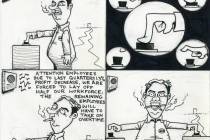Eureka works at preserving history
Back when the smoke from its busy ore smelters covered half the Diamond Mountains with a prosperous shroud, Eureka was known as “the Pittsburgh of the West.” That was a high compliment in the 1800s.
Today, the ranching and mining town and its namesake county are close to the heart of Nevada’s gold country, the lead-silver operations of the past having long since been replaced by the enormous gold mines of the historic Ruby Hill mining district that make the sparsely populated area technically one of the wealthiest in the country.
But the most memorable part of Eureka isn’t its mining heritage or the rugged majesty of Mount Prospect in winter. It’s the fact that the town located approximately 310 miles north of Las Vegas on U.S. 50 — dubbed “America’s Loneliest Road” — has managed to preserve its historic opera house, courthouse and the Jackson Hotel that makes it something not to be missed now that the smoke has cleared.
In August, the Eureka County Fair is one of the highlights of the year in a 4,108-square-mile area that has just three towns, including Beowawe and Crescent Valley, and a population of 2,001 as of 2012.
Just how big is mining to Eureka County? In 2013, it provided more than 4,200 jobs — double the population of the area, according the the Nevada Department of Employment Training and Rehabilitation.
It was the mineral wealth found in the nearby mountains that attracted non-Native Americans to the area as early as 1863. Gold and silver traces brought the first rush of prospectors to Eureka in 1869. Substantial discoveries of gold and lead-silver quickly swelled the town, whose promoters snapped their suspenders to tout it as the second most productive metropolis in Nevada after Virginia City. The state Legislature in the 1873 session officially carved Eureka County out of the Nevada countryside.
At the height of its original rush, Eureka was called “the second town of importance in Nevada” and sported a population of 7,000, two telegraph lines, three newspapers including the legendary Sentinel, and a narrow-gauge railroad that moved passengers 90 miles to a larger line at Palisade and connected it to the rest of the West.
As nothing spelled prosperity like the shimmering symbols of justice and high culture, the courthouse and opera house were quickly recognized as some of the finest new buildings in the region. Thanks in large part to the efforts of longtime resident and Nevada Humanities Committee member Wally Cuchine, the opera house has been fully restored and is the site of a full schedule of community events. As they were when first built, the buildings remain a considerable and deserved source of community pride.
As far back as 1879, when town promoter Lambert Molinelli went to great lengths to note the important symbolism of the public edifices.
“Among the prominent buildings lately erected, and now under process of construction, can now be mentioned the International Hotel, Jackson House, Sentinel building, and Opera House, each being handsome two-story brick structures, to say nothing of the many elegant private residences that adorn our town,” he enthused in 1879.
The Sentinel building no longer prints the feisty hometown newspaper, but it serves as a museum that features printing presses and antiques. Copies of the newspaper cover part of its walls.
In an interview several years ago, Eureka County Clerk Joan Shangle captured the place’s small-town sensibility. Her family had attended public school in Eureka for more than 120 years.
“That’s the appeal of a small town,” she said. “It’s the best place to raise a family. After the kids graduate from high school there’s really nothing here for them. They have to get out, but this is really the best place to come back and raise your family. The schools are great, and so is the tranquility we have here. It’s not a rush-rush life. Everyone is kind of laid back. I think more people need to take this lifestyle in.
“People leave here, but it seems like everyone finds their way back.”
John L. Smith writes for the Las Vegas Review-Journal. Email him at jsmith@reviewjournal.com or call (702) 383-0295.
















